This post may contain affiliate links. Learn more.
A salad platter makes an easy and elegant meal — it’s basically a party on a plate. Salmon Nicoise salad is a beautiful, flexible, and crowd-pleasing theme for a platter salad. Here’s how to make it, with variations.
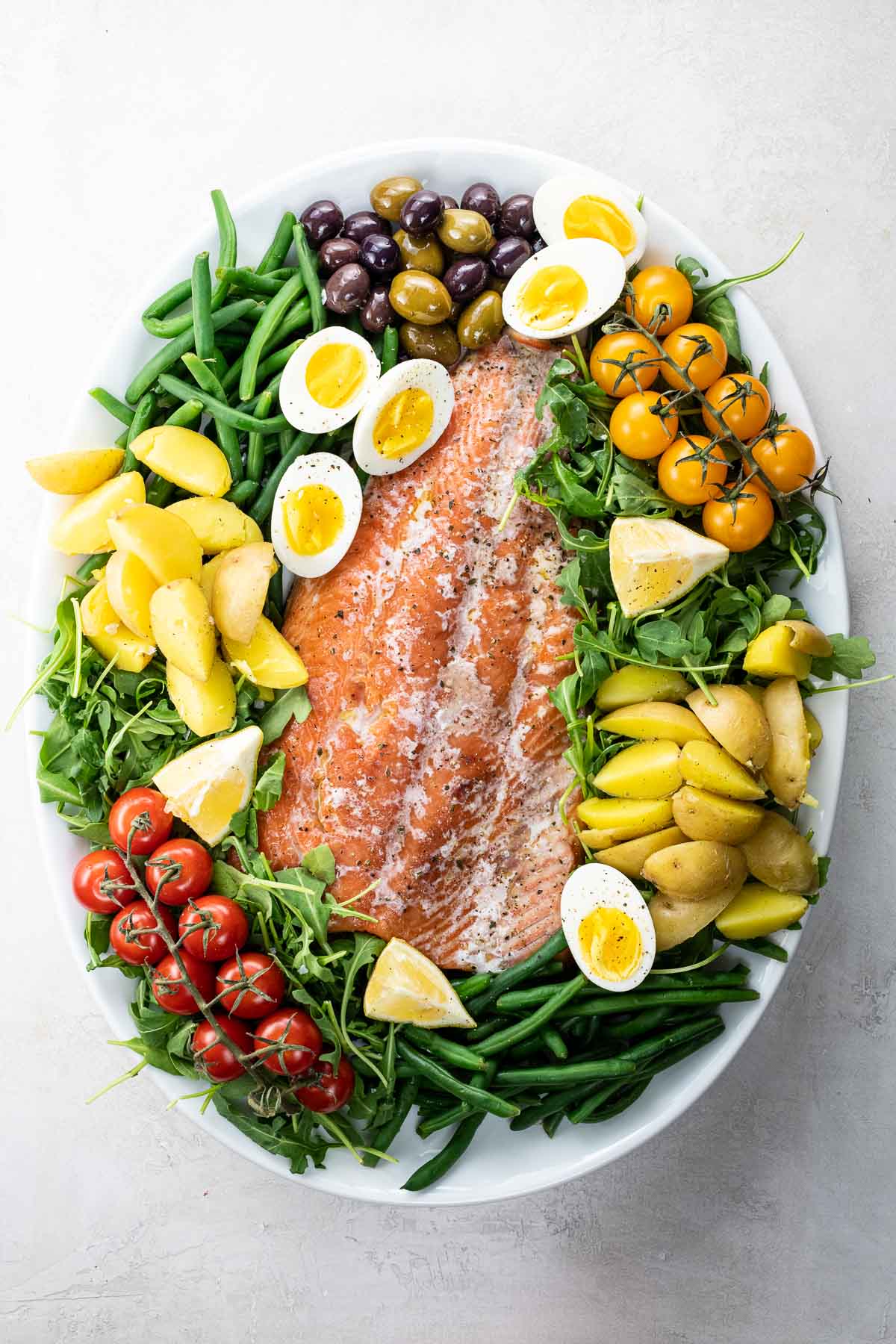
Why we love this recipe
I’ve loved salade Niçoise for four decades and counting, ever since my mom used to make it for the two of us for lunch and call it Little Girl Salad for me and Big Girl Salad for her. Here in the modern era, a chill, platter salad variation on an old favorite works equally well for family dinners and parties. It’s:
- Easy: Good ingredients need little adornment (but don’t let me stop you). This salad can be as quick and easy or as jazzed up as you like.
- Elegant: I mean, just look at it, right? Scroll down for tips on how to style a salad platter.
- Flexible: I’ve given you several cooking method and ingredient options, and you can play beyond that to your heart’s content.
- Make-ahead friendly: Prepare all the elements in advance if you like and assemble shortly before serving.
It’s a truly satisfying meal on its own — an absolute role model for “I am enough.” That said, if you’re so inclined, pair it with a chilled bottle of your favorite dry white wine and a pieces of good baguette.
I first published a version of this recipe here way back in 2010. I’ve updated the post for clarity and added more options to the recipe itself.
What you’ll need
Here’s a glance at the ingredients you’ll need to make this recipe.
For the salmon
You can grill or slow-roast the salmon according to the instructions in the recipe card. Either way, you don’t need much.
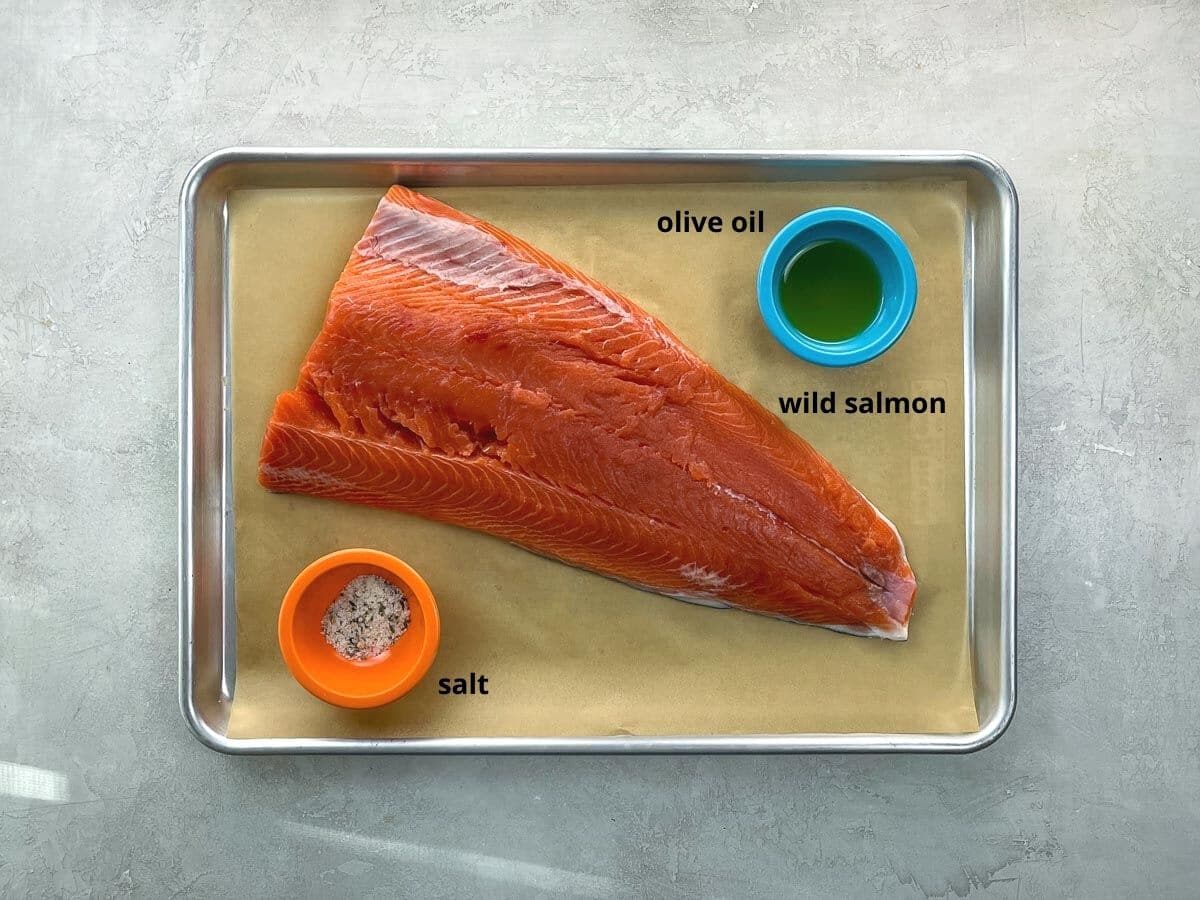
- Tuna is the classic protein in salade Niçoise, but salmon makes a beautiful variation.
- We always choose wild salmon over farmed salmon. MSC-certified sockeye, coho, and king (chinook) salmon from Alaska are all great choices. For a salad platter, I like to buy a large filet that hasn’t been cut into pieces, just because it looks pretty and feels a little special. You don’t have to go this route if you’d prefer to work with individual portions. Ask the fishmonger to remove the pin bones for you, and leave the skin on.
- I’ve pictured my homemade herb salt here, but you can of course use regular salt.
For the salad
I’ve incorporated many of the classic salade Niçoise ingredients into this rendition of the dish, but you can feel free to be flexible.
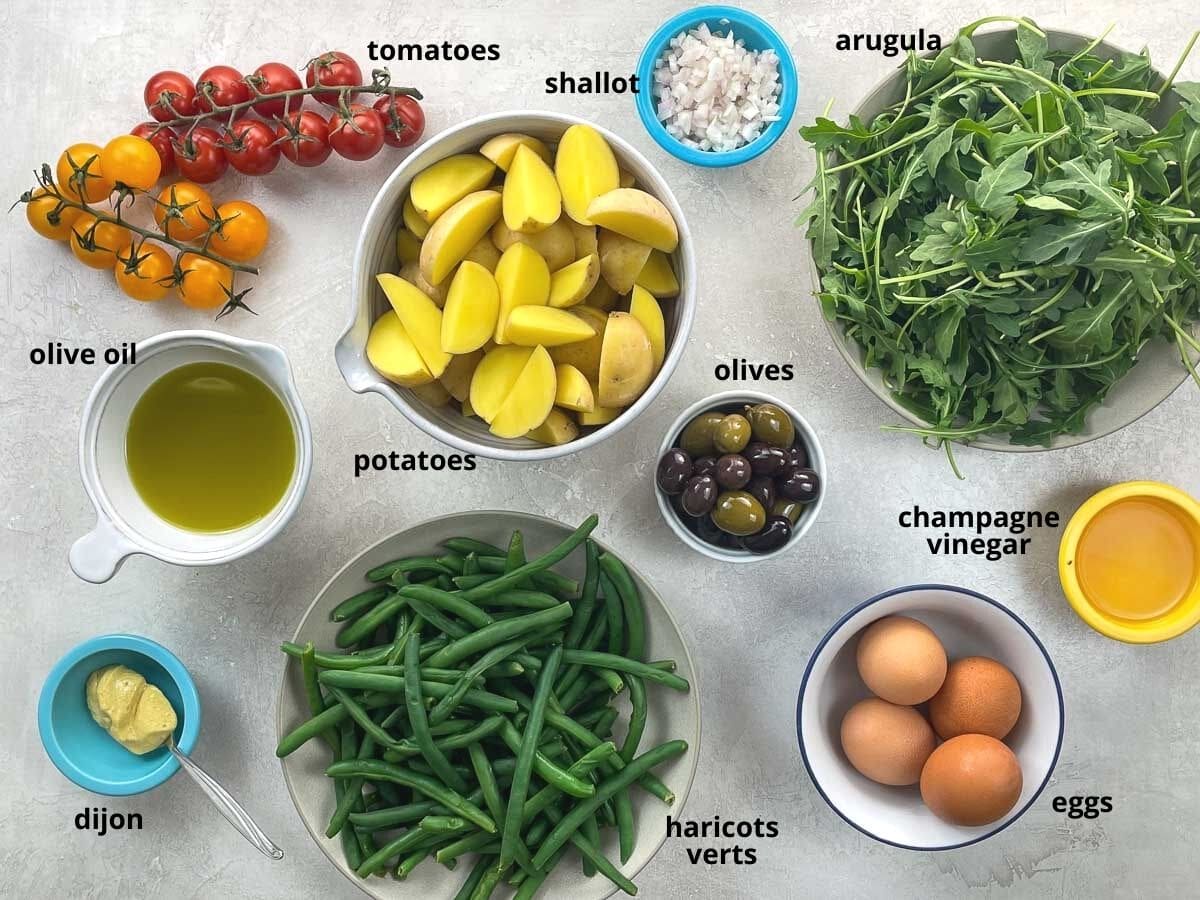
- Haricots verts are slim, delicate, French-style green beans. They’re available in lots of supermarkets, but if you can’t find them, you can 100% use regular green beans.
- Tomatoes add a hint of sweetness and a pop of color, so I like to include them. You can use any kind that’s available and in season.
- A few boiled eggs are a classic addition.
- Olives add brininess. I’ve pictured a mix of kalamatas and cerignolas here, and Moroccan oil-cured olives below. You can use any kind that makes you happy.
- For the leafy greens, I like the way arugula cuts through the richness of salmon. A soft leaf lettuce or mesclun would be a more traditional choice.
- Small gold-fleshed potatoes boil up beautifully, retaining their shape when creamy and tender.
How to make it
Here’s an overview of what you’ll do to prepare the ingredients for a salmon Niçoise platter salad. You can see the steps in action in the video that accompanies this post, and get all the details in the recipe card below.
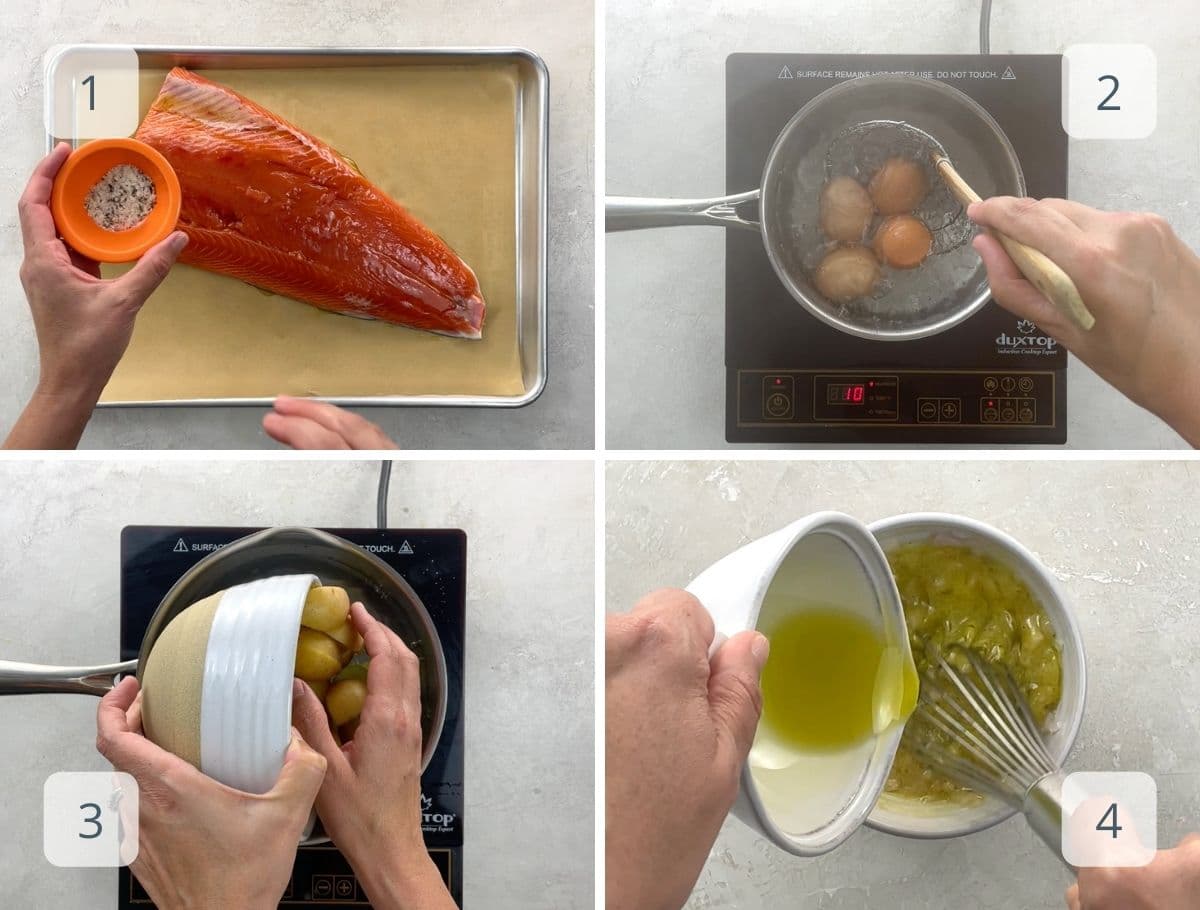
- Cook the salmon. You can grill it or slow-roast it according to the instructions in the recipe card below. Either way, you’ll start with a light coating of olive oil and a sprinkle of salt.
- Boil the eggs. You can choose between seven-minute jammy eggs and the 12-minute perfect hard-boiled variety.
- Start the potatoes in cold, well-salted water and boil until tender. Steam the green beans until crisp-tender.
- Whisk up the simple, flavorful champagne vinaigrette. You’re ready to assemble!
How to assemble a salad platter
This process is at least as much art as science, and whatever looks good to you looks good to me. But here are a few general principles to keep in mind when assembling a platter salad, along with the steps I’ve used.
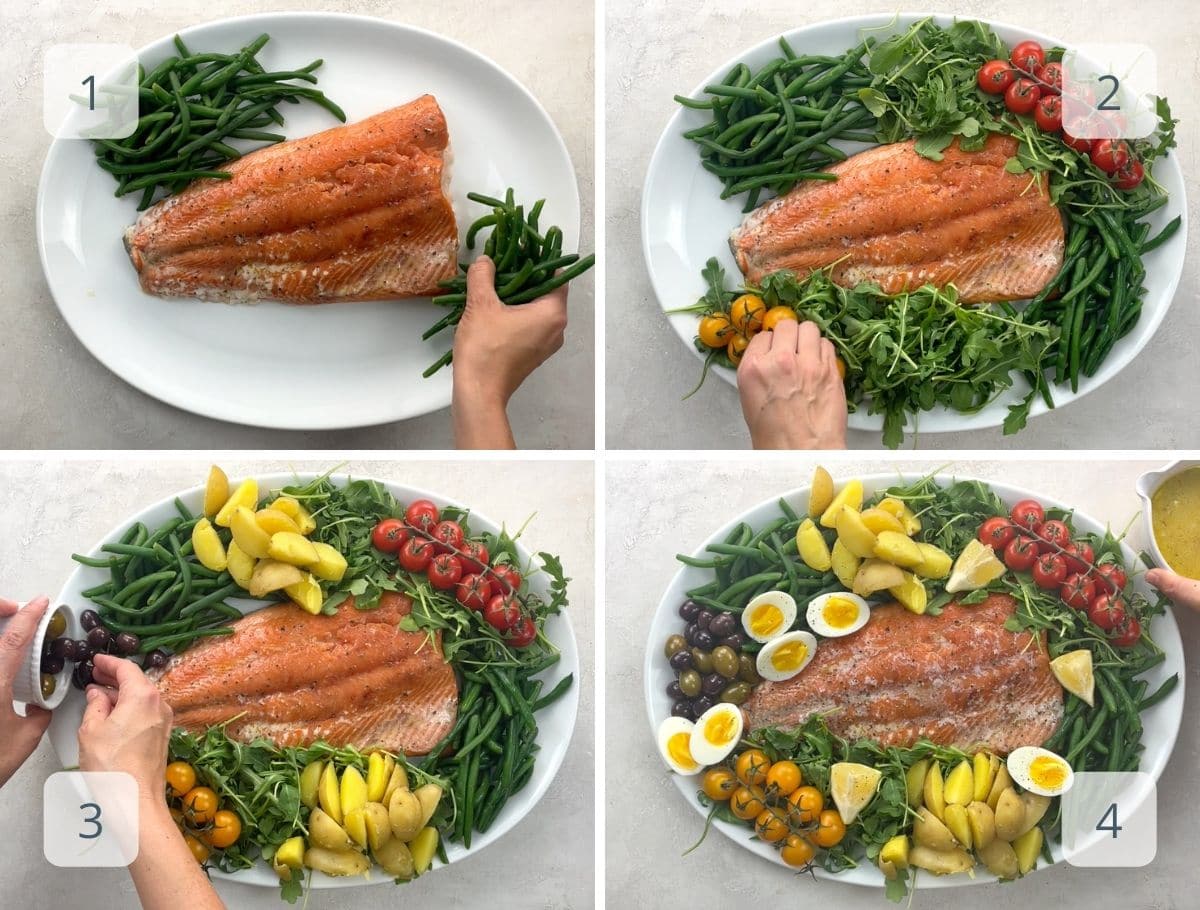
- Place the cooked salmon in the center a large oval-shaped platter with a little bit of a lip around the edge. The key to creating a look of abundance is to choose a platter that’s just barely big enough to hold your ingredients. I’m using this one. (That’s why I prefer a platter with a lip, to help contain any overflow.) Layer on the green beans and salad greens. I like to create two to three sections of each ingredient, vaguely but not perfectly balanced across the platter from each other.
- Layer on the tomatoes. Here I’ve used cherry tomatoes and kept them on the vine. It looks pretty and couldn’t be easier, but you can do whatever you like.
- Create a couple of slightly unruly piles of potatoes. Here I’ve added the olives all in one section rather than balancing them across the platter. Small bits of asymmetry help to keep things from feeling too planned and orderly.
- Add the eggs and a few lemon wedges, squeezing some lemon directly onto the salmon. Keep layering and filling in gaps until you’re happy with the result. Sprinkle the whole thing with flaky sea salt and some freshly ground black pepper. Place the dressing alongside the platter. That’s it!
Variation: Layers of flavor
If you’ve got the time and inclination, you can make this salad platter extra special by swapping in these recipes:
- Slow-roasted salmon with shallots and capers
- Potato salad with bacon and herbs
- Haricots verts with shallot vinaigrette
Variation: Grilled salmon Niçoise with asparagus
Here’s another look to inspire your platter salad dreams. This version incorporates grilled salmon, asparagus, and lemon slices, plus my favorite Moroccan oil-cured olives.

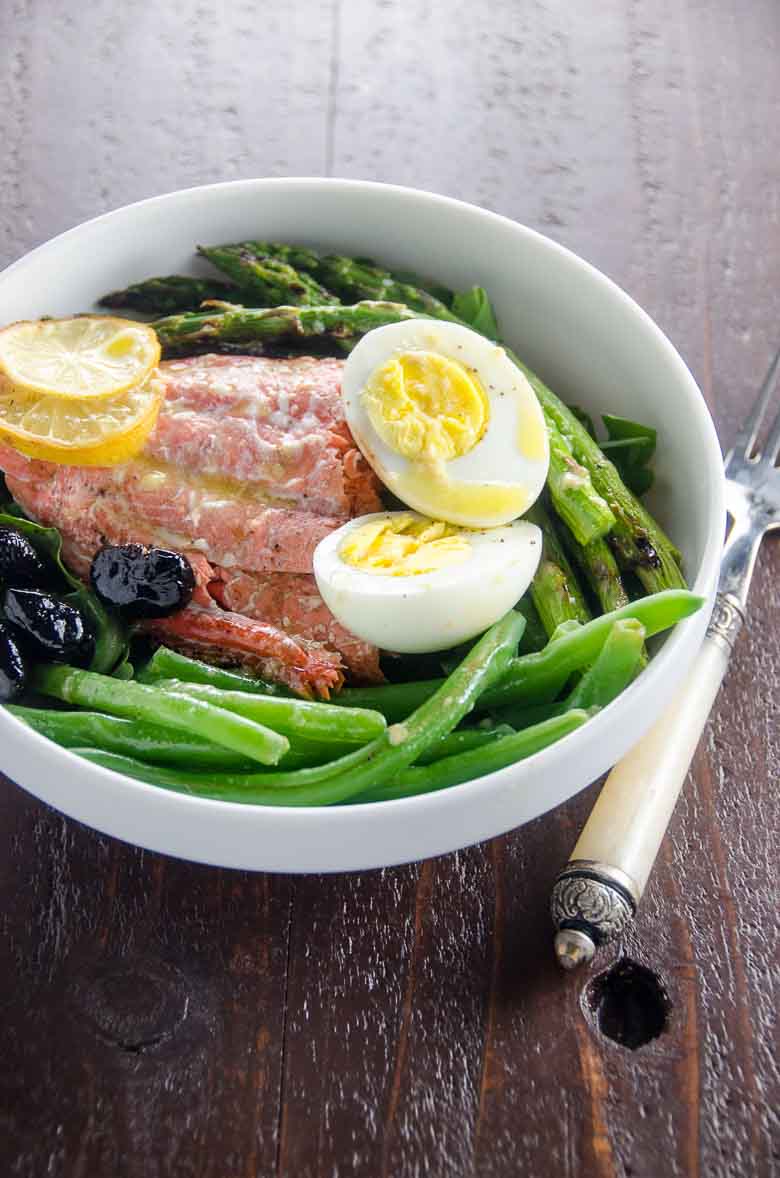
Expert tips and FAQs
Don’t I always? You can use the same principles to turn any hearty salad into a beautiful platter. Easy contenders include: Cobb salad, chicken Caesar, flank steak salad, taco bowls, and poke bowls.
You can make all the elements of a salmon Niçoise platter up to about 24 hours in advance and store them separately in the fridge. Assemble the platter shortly before serving.
Leftovers, except dressed or otherwise mussed leafy greens, will keep in the fridge for a week. You can reinvent them if you like! Try transforming them into this fabulous summer pasta recipe.
More favorite platters
If you love breezy entertaining (or hey, elevated yet simple family dinners) as much as I do, don’t miss these other favorite platters. They’re always on heavy rotation in our kitchen.
- Dreamy burrata platter
- Epic cheese board
- Bagna cauda and crudités
- Fries board
- Deviled egg bar
- Fruit plate with chocolate dip
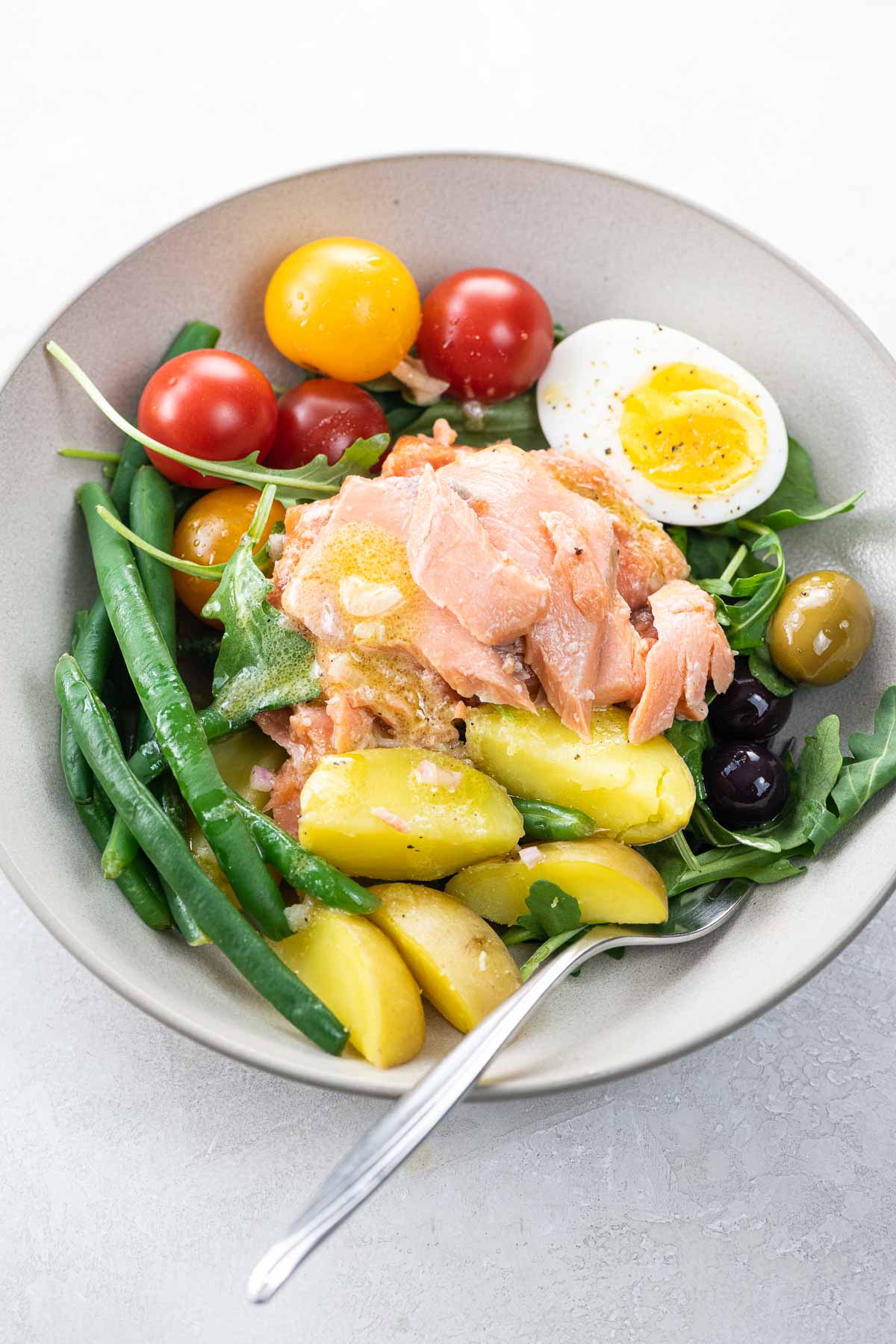
Summarize & Save This Content On
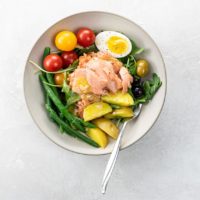
Niçoise Salad Platter
Ingredients
For the salmon
- 1 whole fillet wild Alaskan salmon, 2-3 pounds/900-1(350 grams)
- 1 tablespoon (15 ml) olive oil
- ½ teaspoon fine sea salt
For the salad platter
- 4 eggs
- 1 pound (454 grams) small gold-fleshed potatoes
- 1 pound (454 grams) haricots verts
- 5 ounces (142 grams) baby arugula
- 8 ounces (225 grams) tomatoes, sliced or cut into wedges if large
- ½ cup kalamata, oil-cured or other olives
- 1 lemon, cut into wedges
- Fine sea salt and freshly ground black pepper
- Flaky sea salt, such as Maldon for finishing
For the champagne vinaigrette
- 1 small shallot, minced
- 13 tablespoons (45 ml) champagne vinegar
- 1 tablespoon dijon mustard
- ½ teaspoon fine sea salt
- ¼ teaspoon freshly ground black pepper
- 6 tablespoons (90 ml) extra-virgin olive oil
Instructions
- Cook the salmonYou’ve got two great options here: grilling and slow-roasting.
- To grill: Preheat grill to high (about 400-500°F). Place the salmon skin-side down on a double layer of aluminum foil. Rub the flesh with the olive oil and sprinkle with the salt. Grill salmon until done to your liking, about 8-10 minutes for just barely opaque in the center, depending on thickness.
- To slow-roast: Preheat the oven to 275° F with a rack in the center. Place the salmon skin-side down on a rimmed baking sheet or baking dish. Rub the flesh with the olive oil and sprinkle with the salt. Roast for 15 to 25 minutes, depending on size and type, until flesh is just barely opaque in the center, and still quite soft.
- Cook the additional elements
- To cook the eggs, bring a small pot of water to a boil. Gently lower in the eggs (I like to use a spider strainer for gentle handling.) For jammy eggs, boil for seven minutes. For hard-cooked, boil for 12 minutes. When the timer dings, immediately remove eggs from pot and place them into a large bowl filled with ice water until cooled.
- To cook the potatoes, halve or quarter into bite sized pieces unless they’re very small. Place into a medium pot and cover with cold, well-salted water. Bring to a boil, then lower heat and simmer briskly until tender, about 10 minutes. Drain.
- To cook the green beans, fill a shallow, lidded pan with a quarter inch of water and bring to a boil. Meanwhile, trim any coarse ends from the beans. Add trimmed beans to pan, cover, and steam until crisp-tender, about five minutes depending on thickness. Plunge cooked beans into the bowl of ice water.
- Make the dressing
- Place the shallot into a small mixing bowl.
- Pour in the vinegar and let it sit for five minutes.
- Whisk in the dijon, salt, and pepper.
- Add the olive oil in a steady stream, whisking to emulsify.
- Assemble the salad platter
- Place the cooked salmon in the center a large oval-shaped platter with a little bit of a lip around the edge. The key to creating a look of abundance is to choose a platter that’s just barely big enough to hold your ingredients. (That’s why I prefer a platter with a lip, to help contain any overflow.)
- Layer on the green beans and salad greens. I like to create two to three sections of each ingredient, vaguely but not perfectly balanced across the platter from each other.
- Layer on the tomatoes. Here I’ve used cherry tomatoes and kept them on the vine. It looks pretty and couldn’t be easier, but you can do whatever you like.
- Create a couple of slightly unruly piles of potatoes.
- Add the olives. I’ve placed them all in one section rather than balancing them across the platter. Small bits of asymmetry help to keep things from feeling too planned and orderly.
- Add the eggs and a few lemon wedges, squeezing some lemon directly onto the salmon.
- Keep layering and filling in gaps until you’re happy with the result.
- Sprinkle the whole thing with flaky sea salt and some freshly ground black pepper.
- Place the dressing alongside the platter. You’re ready to serve!
Notes
- We always choose wild salmon over farmed salmon. MSC-certified sockeye, coho, and king (chinook) salmon from Alaska are all great choices. For a salad platter, I like to buy a large filet that hasn’t been cut into pieces, just because it looks pretty and feels a little special. You don’t have to go this route if you’d prefer to work with individual portions. Ask the fishmonger to remove the pin bones for you, and leave the skin on.
- Haricots verts are slim, delicate, French-style green beans. They’re available in lots of supermarkets, but if you can’t find them, you can 100% use regular green beans.
- Tomatoes add a hint of sweetness and a pop of color, so I like to include them. You can use any kind that’s available and in season.
- Olives add brininess. I’ve pictured a mix of kalamatas and cerignolas in the main recipe, and Moroccan oil-cured olives in the grilled variation. You can use any kind that makes you happy.
- For the leafy greens, I like the way arugula cuts through the richness of salmon. A soft leaf lettuce or mesclun would be a more traditional choice.
- If you’re grilling the salmon, consider adding some asparagus to the mix. Toss with a bit of olive oil, salt, and pepper, place it in a grill basket, and grill alongside the salmon until lightly charred and tender.
- If you’ve got the time and inclination, you can make this salad platter extra special by swapping in these recipes: Slow-roasted salmon with shallots and capers // Potato salad with bacon and herbs // Haricots verts with shallot vinaigrette
- You can make all the elements of a salmon Niçoise platter up to about 24 hours in advance and store them separately in the fridge. Assemble the platter shortly before serving.
- Leftovers, except dressed or otherwise mussed leafy greens, will keep in the fridge for a week. You can reinvent them if you like! Try transforming them into this fabulous summer pasta recipe.
Nutrition
Nutrition information is automatically calculated, so should only be used as an approximation.
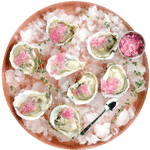

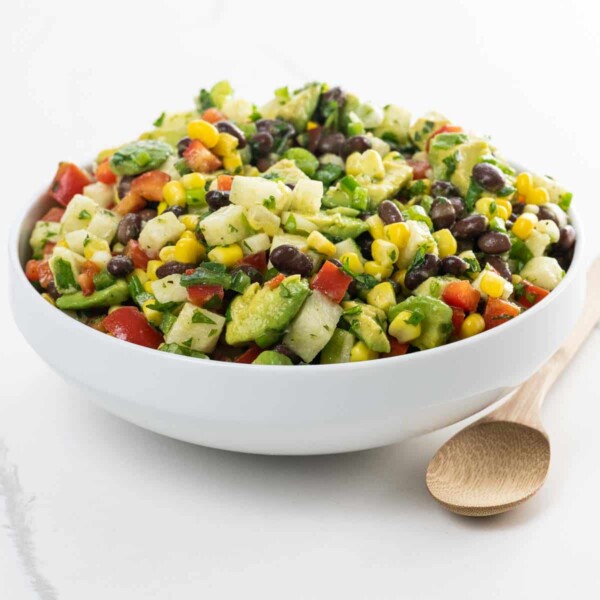
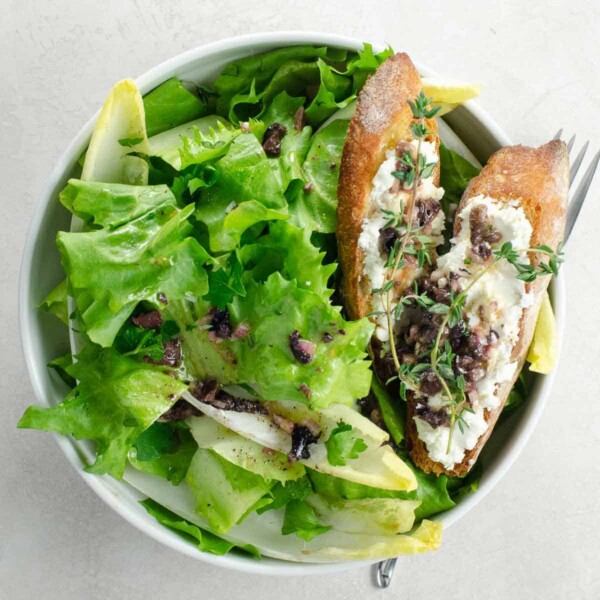
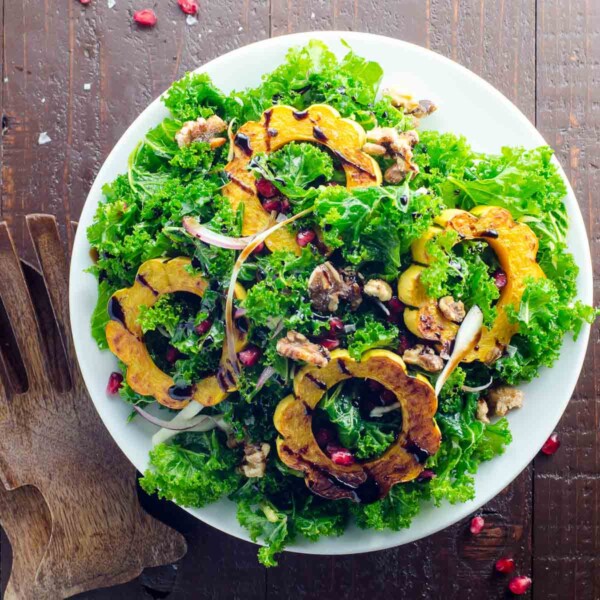
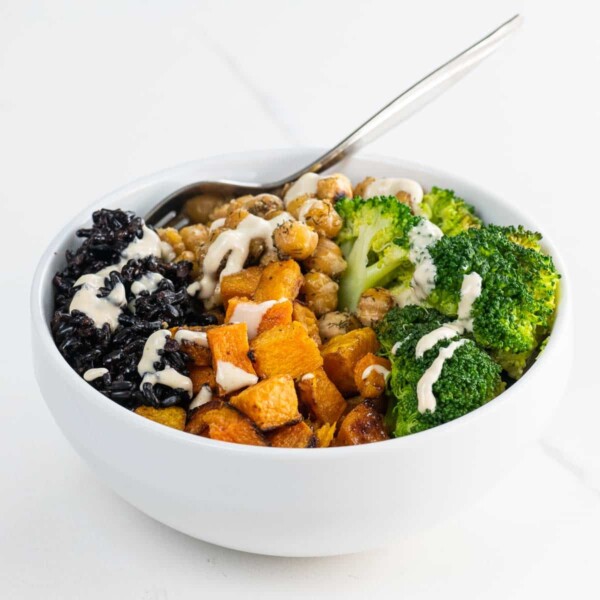
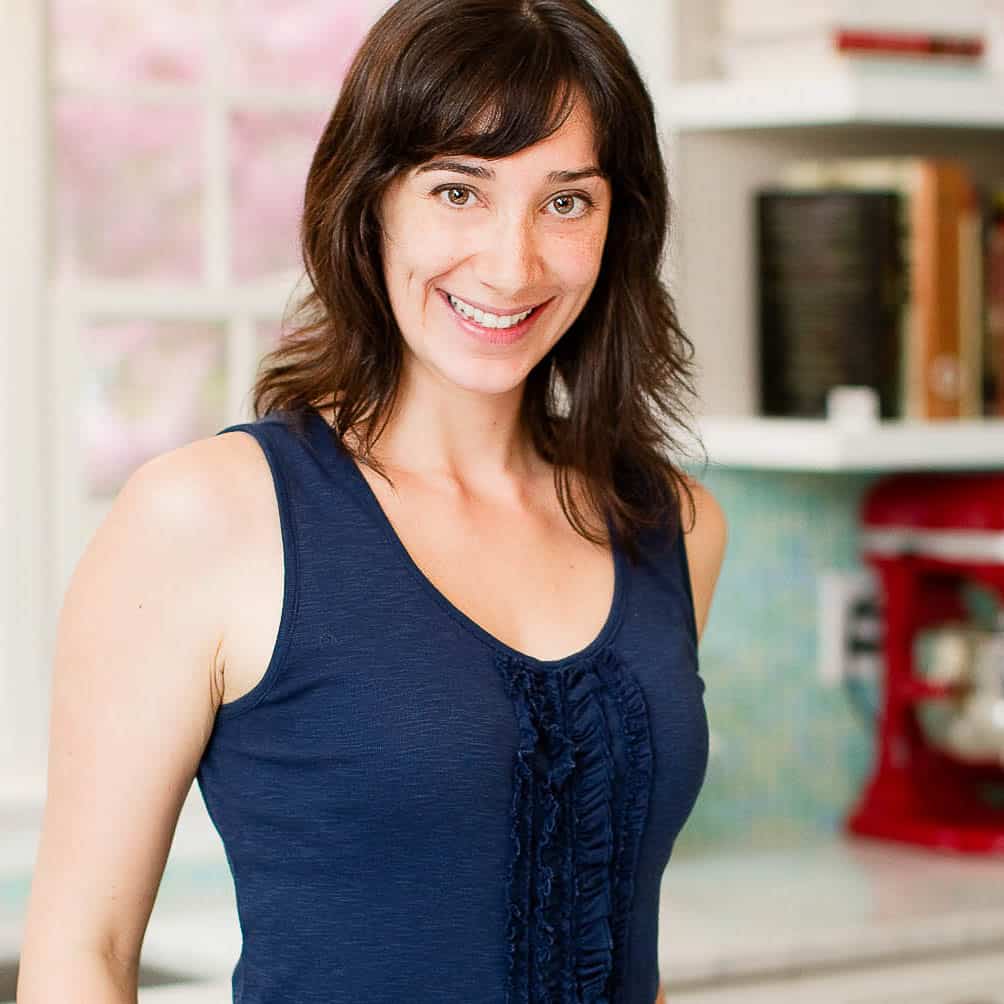






Thank you so much to everyone for sharing your ideas and inspirations on sustainability. I’ll be posting about my favorite ideas and the winner of the book this afternoon. xx
I couldn’t agree with you more about the food movement taking itself too seriously. The feminism analogy is spot on. Until we can open our arms wide and embrace everyone, recognizing that American parents are darned tired and need to go to the drive-through every once in awhile, we will stay marginalized. Accept, appreciate, support change. That’s my motto.